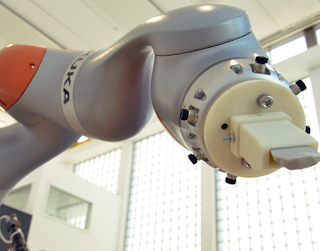We typically associate robotics with tasks that area unit, if not high technical school, a minimum of trendy in nature. That’s why it’s therefore cool to envision a automaton being tailored for a task that's expressly ancient: scraping away at animal skins with replicas of stone tools found at anthropology sites.
Radu Iovita, associate degree archeologist at the Monrepos center in Neuwied, Germany, studies microscopic wear patterns on ancient stone tools to do to work out however they were used. the standard thanks to do that wear analysis is to create a contemporary copy of the stone tool that you’re watching, so scrape a bunch of animal hides with it victimization the technique that you’ve guessed was used on the first. If, once a moment, your new stone tool shows an equivalent style of wear pattern that the recent stone tool will, you'll have some level of confidence that you’ve been victimization an equivalent technique. If the wear and tear pattern is completely different, you create a brand new tool and take a look at once more.

This, to place it gently, will take a moment, and Iovita needed to seek out how to standardize and expedite the method. And so, robots. Iovita noncommissioned the assistance of academic Jonas Buchli at ETH Zurich, WHO conscripted a Kuka light-weight automaton arm to exactly scrape tools against animal hides over and over, and once each fiftieth scrape, place the sting of the tool below a magnifier to record the wear and tear patterns. This video is definitely in German, however it will show however the automaton works (at 1:40):
Look here
The hope is that eventually, a fleet of robots are going to be able to develop a colossal information of tools anyplace from 50,000 to three million years recent that correlates differing kinds of tools, techniques, wear patterns, and usage characteristics. however in step with a commentary regarding Iovita’s work, not everyone seems to be able to embrace robotic archaeology:
"Currently, Iovita is experiencing some opposition from among his own profession. Some believe that manual experiments area unit nearer to the past reality; others realize that use-wear analysis normally doesn't advance anthropology theory. Iovita thinks this is often chiefly owing to the very fact that the majority archaeologists have a humanities background and aren't conversant in the globe of engineers."
OH SNAP.
And on the primary purpose, it raises the question of what “manual” extremely suggests that. in step with my girlfriend’s 15-pound Compact Edition of the English language lexicon (which will solely be browse with a magnifying glass), “manual” suggests that “done or performed with the hands.” the primary recorded definition, however, is from a 1406 verse form known as La Male Regle, that is slightly before the introduction of Kuka’s light-weight robotic arms. So, it appears probably that Thomas Hoccleve (this dude) neglected to contemplate them once he wrote La Male Regle. we will forgive him for that, I guess.
“Manual” additionally suggests that “as against automatic,” and if you place these 2 definitions along, it’s pretty clear that manual experiments aren’t supposed be compatible with things like robots, however in my opinion, this angle is as noncurrent as La Male Regle. What this automaton is doing is manual, as so much because the stone and animal skin area unit involved, since it’s exactly replicating the motions and forces generated by somebody's hand. the very fact that it isn’t somebody's hand doesn’t, in observe, matter, since any characteristic of somebody's hand may be programmed into the automaton.
What’s notably attention-grabbing to me regarding applications like these is however it probably changes the which means of the word “handmade.” Like, if you have got a automaton mimicking the motions of somebody's hand to finish a task or produce associate degree object specified if you performed a form of mathematician check and couldn’t tell a robotic result from somebody's result, would you then be forced to decision objects created by robots “handmade?”
For example, take that automaton cook from last Friday which will precisely duplicate the motions of somebody's cook to make an almost identical copy of a crab soup. is that the crab soup created by the automaton any less “handmade” than the one created by the human chef? I suppose you may argue that hand-crafted instead ought to talk over with one thing that's “unique,” however it might be trivial to include some minor components of randomness into the programming of a automaton to duplicate that method, whether or not it’s for scraping tools against animal skin or getting ready soup.
Post about "Robot Arm Brings Humanity Back to the period of time"